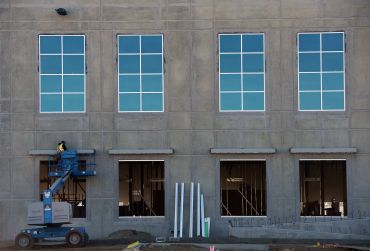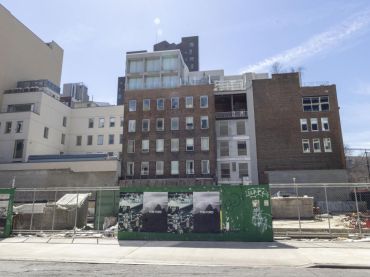New York’s Classic Skyscrapers Reinvent Themselves to Better Compete
Don't count out the likes of the Empire State Building, the General Motors Building, and 1271 A of A in the era of flight to quality
By David M. Levitt March 28, 2023 9:00 am
reprints
For the Flatiron Building, the stakes could not be higher.
For 121 years and counting, the Flatiron has been a signature of New York City: its distinctive triangular shape; its ornamentation; its spot at the convergence of Broadway and Fifth Avenue across from the southernmost end of Madison Square; its history as one of the city’s first skyscrapers; its distinction as one of legendary architect Daniel Burnham’s most important statements; its etymological inspiration for the surrounding neighborhood, the Flatiron District.
It is also pretty much empty.
Its last tenant, the Macmillan publishing company, which occupied the entire office portion of the building, moved out in 2019, leaving 205,000 square feet of offices vacant (though a T-Mobile store occupies the retail base). That capaciousness is of special interest to its next owner, which was supposed to be Abraham Trust’s Jacob Garlick, the winner of a March 22 auction for the Flatiron with a bid of $190 million. Garlick apparently failed, however, to put down the necessary 10 percent deposit on the place within two days of the auction, and now it looks like the Flatiron might be headed to the block again.
For any new owner to succeed, that owner will have to monetize the space — which involves finding an occupant or occupants for whom being in the Flatiron Building is worth what they will be asked to pay. That also means having to contend with all the concerns that other landlords are grappling with, including the attractiveness of any space to potential office workers and the competition with remote locations.
The Flatiron is just one of many classic, even iconic, New York towers that find themselves competing like perhaps never before. They’re battling against not only a newer class of skyscraper that has been raking in record rental rates with sumptuous tenant lounges, sophisticated air filtration systems, lush outdoor terraces, bespoke food and beverage services, and other amenities, but also against the notion that coming to the office is no longer compulsory.
This older stock of the city’s most famous skyscrapers includes the Flatiron and the Empire State Building (visible through windows in the Flatiron’s north-facing prow), the Chrysler Building and Rockefeller Center’s towers. Even more modern landmarks such as the MetLife Building, the Seagram Building, the General Motors Building and 9 West 57th are getting on in years, and have to compete with newer state-of-the-art towers like One Vanderbilt, One Manhattan West, Hudson Yards’ towers and 425 Park Avenue in a climate where decision-makers for companies that pay the freight lean on the catchphrase “flight to quality.”
“New construction obviously has a higher rent premium than older properties,” said Michael Slattery, an associate field research director for brokerage CBRE (CBRE). “Those [buildings] have that global recognition. From a marketing standpoint, people know what those buildings are.”
But that currency isn’t as valuable anymore. “Things are different — tenant desires and things like that,” Slattery added.
According to data from CompStak, a research firm which crowdsources data from the leasing and sales brokers who make the deals, starting rents for new construction rose almost 17 percent from 2019 to 2022, covering the pandemic years. The rise in effective rents — rents after tenant improvement allowances, free rent concessions and other sweeteners are taken into account — was 9.4 percent.
For the same period, starting rents for classic buildings — a category that includes the Empire State Building, the MetLife Building and what used to be known as the McGraw-Hill Building — fell 11.4 percent, and effective rents fell 13 percent.
CompStak does not have the last rent paid by Macmillan at the Flatiron Building. (Its calculations did not include the Flatiron neighborhood.)
The data showed that new construction — a category that included 30 Hudson Yards, 425 Park and One Vanderbilt — averaged $108.32 a square foot for effective rent last year. A category called trophy buildings, which includes the GM Building, the former Sony Tower at 550 Madison Avenue, the Seagram Building, 9 West and One Bryant Park, averaged $97.23 a square foot. Classics averaged $67.04.
Data from brokerage JLL showed a 41 percent rent premium for new Class A construction over historical Class A from 2019 to 2022, the pandemic years. In the four years leading up to 2019, the spread was 15 percent. The wider distance can be attributed to an “ever-growing demand for the highest-quality
spaces,” the brokerage said.
Owners of classic buildings are not taking it lying down. Many are loading up their buildings with amenities to compete on a more equal footing with the new generation of trophies.
In one case, JLL Vice Chairman Cynthia Wasserberger pointed out that at the Seagram Building, owner RFR Holding, Aby Rosen and Michael Fuchs’ company, halved its underground parking garage and installed “something for tenants to enjoy.” That something is called “The Playground,” which includes fitness spaces, a basketball court and conference space that Wasserberger referred to as a “town hall,” plus food and beverage facilities.
Owners have done similar things at other classics, including the Chrysler Building, the Empire State Building and the GM Building.
“The popular narrative is just incorrect — the concept that older buildings will be troubled and cannot compete; the concept that only newer buildings have recorded positive net absorption,” said Tony Malkin, CEO and chairman of Empire State Realty Trust, the real estate investment trust that owns the Empire State Building. “In 2022, we expanded our lease rate by 260 basis points to 90 percent. We increased our office occupancy by 210 basis points to 86 percent. And we’ve got very good momentum for 2023.”
Malkin pointed to videos made by some of ESRT’s tenants, including LinkedIn, the social media platform that concentrates on professional networking. The company’s video shows Nawal Fakhoury, LinkedIn’s director of employee experience, calling the Empire State Building “the coolest building I will ever work in.”
Of course, the Empire State Building has a revenue source that only four other buildings in Manhattan have: an observatory. A decade ago, there were only two — Empire State and the Top of the Rock (Rockefeller Center). One World Observatory at One World Trade Center opened in 2015, followed by The Edge (30 Hudson Yards) and The Summit (One Vanderbilt).
“We have demonstrated our ability to win in the flight-to-quality category,” Malkin told a Citigroup analyst at a March 6 conference. “We have a great price point for buildings that are well amenitized. Not just lobbies and elevator cabs, but the guts have been modernized.”
He was referring to both the Empire State Building and the company’s other office buildings, which include nine Manhattan properties and three more in the northern New York suburbs of Harrison, N.Y., and Stamford, Conn. All told, ESRT, a publicly traded real estate investment trust, has 8.9 million square feet of offices, 2.7 million square feet of which are the Empire State Building.
According to CompStak, the average effective rent for the pandemic period from second quarter 2020 to the fourth quarter of 2022 for the Empire State Building was $59.82 a square foot. According to ESRT’s fourth-quarter 2022 supplemental earnings statement filed with the Securities and Exchange Commission, the building’s annualized rent per occupied square foot was $63.34 a square foot.
“We offer a tremendous bargain,” Malkin told Commercial Observer. “We are not brand new, yet we offer buildings with modernized amenities, energy efficiency and indoor environmental quality and a spectacular location.”
Effective rents for the same 2020-2022 period, according to CompStak, were $63.78 a square foot at the MetLife Building at 200 Park Avenue, and $76.97 at the former McGraw-Hill Building at 1221 Avenue of the Americas. At the GM Building, considered a trophy, effective rent was $99.31. At the former Sony Tower, it was $107.76.
At One Vanderbilt, the average effective rent during the pandemic was $126.41 a square foot. At 30 Hudson Yards, the tallest tower at the complex developed by Related Companies and Oxford Properties, it was $114.88.
At 1271 Avenue of the Americas, probably still known by some as the Time-Life Building even though the magazines moved out years ago, owner Rockefeller Group has been hard at work keeping that building relevant, an effort that cost it about $600 million, according to Bill Edwards, Rockefeller’s vice president of core holdings. Actor Marilyn Monroe helped break ground for that building, across Sixth Avenue from Rockefeller Center, back in the 1950s, and its vintage furnishings served as the model for the offices in the AMC television series “Mad Men.”
“In general, I’d say we are consistently looking for ways to reposition and redevelop and put the best product we can in front of tenants in the market,” Edwards said. “We’re 100 percent leased on the office side [of 1271] and we have one small retail space we’re in the market with today. There’s definitely been an amenities arms race. If we hadn’t chosen to renovate the building, we would be sitting here with rents much lower. ”
At its next-door neighbor, the former McGraw-Hill Building, Rockefeller is spending $50 million on its plaza alone, Edwards said. The building’s now 97 percent leased, he said.
“The optionality of where people can work today has increased,” Edwards said. “But I do believe that the efficiency of working together will ultimately win the day.”
The old real estate adage that the three most critical things to value are location, location and location has not been supplanted, said JLL’s Wasserberger.
“These buildings have premier locations, and they have very transit-centric locations, which has been an important driver post-COVID. And several of the buildings you mentioned are in the heart of the Plaza District, which still grabs that higher rent-paying or price-insensitive audience of tenants,” she said of the classic towers. “The vintage is secondary to its location. Those buildings are definitely going to trade on location.
“New construction certainly has been topical and newsworthy,” Wasserberger added. “But it doesn’t supplant or replace these iconic buildings. Landlords have used the past few years to reposition these assets in a way that now tenants are seeing the fruits of those changes.”
Asked what she would do if she had the agency on the Flatiron Building, she said she would recommend the new owners do something similar to what was done at the Seagram Building: trade underutilized space for something that tenants would enjoy.
This article originally appeared as part of Commercial Observer’s Tenant Talk newsletter. Please consider signing up for that and other newsletters here.



